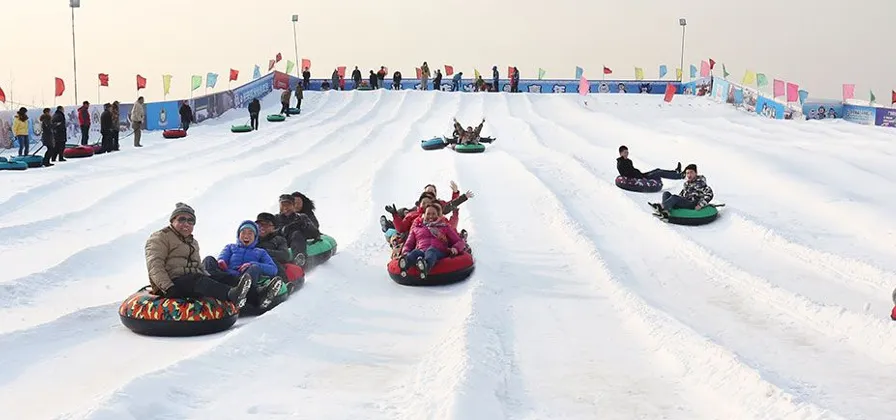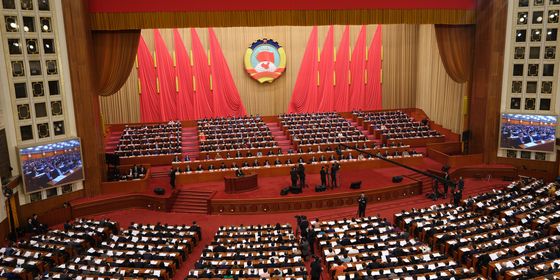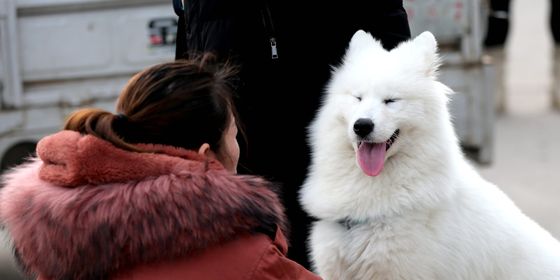Beijing’s winter carnivals help the government to proselytize winter sports ahead of the 2022 Winter Olympic Games
The annual “ice and snow carnival” (冰雪嘉年华) season is currently in full swing in Beijing. For the uninitiated, this is a two-month period (typically from Christmas to late February, or whenever fake snow melts) when parks around this frigid yet moisture-starved northern capital swaddle themselves in artificial-spray-turned-snow and ice to recreate authentic experiences of winter for residents, complete with traditional seasonal activities such as ice-biking, snow labyrinths, and propelling oneself (or others) across a frozen lake on a chair.
Never one to let a good educational opportunity go to waste, Beijing’s winter carnival season has been an annual opportunity for the government to increase public awareness and enthusiasm for winter sports ahead of the 2022 Winter Olympics ever since the city began its bid to become the Games’ co-host city back in 2013.
With five years to go until the big day, it was announced last fall that winter sports will become a compulsory subject for Beijing’s schoolchildren, and efforts to proselytize via this carnival are also ramping up.
Take the Bird’s Nest Stadium, home base of the 2008 Summer Games: it has for three years running provided an “Olympics experience area” for lessons and simulations in various sports that will be featured at the Games (even those that aren’t exactly “popular” abroad, like curling). This year, the organizers promise, its carnival will be bigger and better than ever in order to truly sate “visitor’s Winter Olympic obsession”—even if it’s an obsession that, like the snow itself, must be built from scratch and cultivated with care.
The controversial bid
Beijing’s self-nomination as host city for the 2022 Winter Olympics met with controversy from the start—at least from media outside of China, which cited familiar concerns from the 2008 Games such as budgetary excesses and environmental costs (with a sprinkling of lament of how the Games shouldn’t be awarded to non-democratic nations, for old times’ sake), or alternately expressed bemusement at how a not naturally snowy city could hold the world’s biggest event in winter sports.
For the Chinese public, however, in contrast to the euphoria surrounding Beijing’s bid and eventual selection as host for the 2008 Summer Games, there was mostly indifference, and this was considered a problem to both foreign and Chinese media.
While The New York Times took China’s virtually non-existent winter sports scene as another demonstration of the public’s interest being ignored, the government and media inside China had an altogether different brainwave: whereas one might expect public support for a nation’s Winter Olympics bid to grow from an pre-existing healthy interest among the public in winter sports, there was no reason why it couldn’t be the other way around.
After all, what better way to develop a winter sports culture (or economy) in a country than to host a multi-billion-dollar budget, globally televised event devoted to it? It’s an event that will necessarily lead to the building of state-of-the-art winter sport facilities and raising public awareness, and better yet, will bring to China the world’s undisputed experts in each winter sport all at once.
After Beijing and Zhangjiakou, Hebei, became chosen as co-host cities, Chinese president Xi Jinping promptly declared that the Games will put “300 million people on snow and ice” by 2022, and communities up and down the country, inside the capital and out, began forming youth and adult hockey leagues, building skating rinks, and integrating winter sports into public school curricula.
If the symbolism of the 2008 Summer Games was, to quote almost every media outlet in the world, as China’s “coming-out party” that signalled its arrival as a strong, modern player on the world’s stage, the secondary meaning of the 2022 Winter Games is socioeconomically driven—that is, when it’s not more cynically read as an opportunity for cash-grab given to developers and sports industry firms in cahoots with the government, or simply a misguided power-trip with no deeper interpretation at all.
As The New Yorker has noted, the year when China will host the Winter Games coincides with projections when nearly two-thirds of urban Chinese households will have disposable incomes that put them as upper-middle class or above, affluent enough to sustain a market for winter sports. Developing amenities and a culture for winter sports also dovetail with the government’s new objectives concerning “quality of life” in its economic and social development plans.
Economically, as noted by former Beijing mayor Wang Anxun (in Chinese), the Winter Games and the winter sporting culture it creates the opportunity to foster (pause let that sink in for a second) are also poised to lead the nation’s development of domestic tourism, recreation, a diversified economy for rural and second-or-third-tier cities, as well as transportation network and eventually a high-quality service sector to support these industries. As China’s economy on the whole veers away from manufacturing to innovation and service, popularizing winter sports both economically and culturally signals the adoption of new developmental priorities.
Increased medal count at the Games, of course, could be a side effect of the fostering interest in winter sports, though even in the Summer Games this is apparently not the all-consuming passion it used to be. Currently, China sits at 16th in the all-time medals table for the Winter Olympics, with notable successes in short-track speed skating and pairs figure skating (in the latter, it has in recent years been considered the best in the world, with depth to the team as well as stars).
The rest of the table is almost entirely dominated by developed nations, which is a criticism faced commonly by the Winter Games: that its events are mostly elite and, well, white, requiring optimal conditions and costly equipment. In China as anywhere else, rink time and ski passes are costly, to say nothing of the sports gear. In that sense, that China sees these sports as ticket to a more mature economy and better quality of life is as unsurprising as it is an uncomfortably frank acknowledgement of the socioeconomic realities of winter recreation.
Let the carnival begin
The other major criticism of the Winter Games is its environmental toll, and in the case of Beijing in particular, the main causes for concern are the construction of facilities and potentially massive waste of water in creating snow and ice in an already water-scarce city.
The awareness-raising winter carnivals, rather fittingly, are an ominous prelude to the latter concern: as China National Radio has reported (in Chinese) back in 2013, one ton of water is needed to create two meters of snow by artificial spray, and snow carnivals, ski resorts, and other artificial snow usage around Beijing gobble up at least 1 million tons of water each year, equal to the total water usage by 8,300 Beijing households in one whole year.
According to CRN, these numbers were not tracked until Beijing’s government passed municipal water-saving measures in 2012, and even today there’s no slowdown in the winter carnival scene. At these locations, visitors can find billboards and excited slogans pertaining to the Olympics, or visit well-established carnival locales like Longtan Park or Taoranting Park for education exhibits about winter sports and how other countries do winter recreation in between bouts of chair-skating, replacing a previous penguin-shaped educational exhibit about penguins.
At the same time, these and the aforementioned “simulations” at the Olympic Stadium are activities that bring lots of families together to have fun and stay active together in a season that’s rather gloomy in this city, and if you do go to one, it’s a way to add variety to your Chinese winter (though you might want to consider those that are held in nature reserves or snowier regions outside the city if you’re concerned about environmental impact). And remember, you’ll be on the cutting edge of a new transformation in the Chinese economy.
Cover photo from qianlong.com












